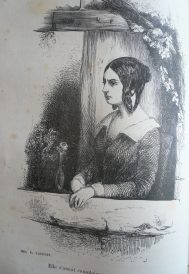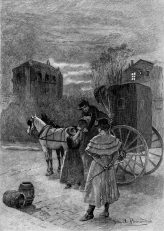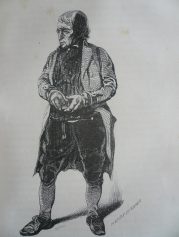
Eugénie Grandet
THE HUMAN COMEDY – Honoré de Balzac Fifth volume of works of Honoré de Balzac edited by widow André Houssiaux, publisher, Hebert and Co, successors, 7 rue Perronet – Paris (1877)

Eugénie Grandet
EUGENIE GRANDET Work published in 1833
Provides Volume I of Scènes de la vie de province (Scenes from provincial life), which completes the series of Scènes de la vie privée (Scenes from private life) already published, and the Scènes de la vie parisienne (Scenes from Parisian life ) announced a few months earlier.
Dedicated work : A MARIA May your name, you whose portrait is the most beautiful ornament of this work, be here like a branch of blessed boxwood, taken from who knows what tree, but certainly sanctified by religion and renewed, ever green, by pious hands, to protect the house. De Balzac. In fact, it’s a dedication to two women: Marie du Fresnay, with whom Balzac was having an affair at the time of the novel, and the new love Balzac had just embarked on in the person of the Polish Countess Ewelina Hanska.
Analysis Eugénie Grandet is Balzac’s best-known novel. It’s a classic that we explain in class. Unlike Père Goriot, which is almost as famous, it has the merit of being harmless. The bad examples portrayed in Père Goriot ‘s novel are, for the French education system, an abysmal model of society. For many contemporaries, Eugénie Grandet is Honoré de Balzac’s most perfect work – much to the chagrin of its author, who has come to believe that this criticism implies a kind of censorship of the rest of his work. On this occasion, he is perfidiously praised for all the qualities he lacks: delicacy, moderation and sobriety. The Balzacians ended up thinking like him. In their rankings, Eugénie Grandet no longer occupies the eminent position it held for so long. Nicole Mozet begins an excellent preface she wrote for this novel with this significant sentence: ” Eugénie Grandet is something of a victim of its reputation as a masterpiece. And, with talent, she proves that it is necessary to defend oneself against this prejudice. In his preface, Balzac defined the characteristics and difficulties of such a subject. Provincial life, he explained, is apparently calm, monotonous, immobile. But beneath this uniformity often lie violent passions and abrupt characters. It’s this contrast that creates the material for any novel set in the provinces. There is, however, one particularity of Scenes from provincial life and which, at this point in the construction of his work, is not yet visible. scenes from provincial life will always be difficult to link to the various groups of characters that make up The Human Comedy. The difficulty does not arise with of Eugénie Grandet because in 1833 Balzac hadn’t yet had the idea of moving his characters from one novel to another. But it’s obvious that there’s already in Eugénie Grandet a unity of action and a unity of setting that would later make it difficult to link the novel to the dramatic ensemble of The Human Comedy. Every “scene of provincial life” is exposed as an isolated fresco. Unlike the other Scènes de la vie de province novels, Eugénie Grandet‘s local milieu is succinctly described. Reduced to the comical chorus of supporters of banker des Grassins and President Fritot, it virtually doesn’t exist. There is no plot other than the patient maneuvering of the two families to lay siege to Eugénie Grandet’s dowry. This ambition is simple. Balzac makes no attempt to complicate it. What he describes in Saumur is not a swarming of ambitions, nor a pitched battle: it’s an assembly of spectators watching and admiring the moves, it’s almost a still life of provincial products. Since all events are but almost imperceptible movements, signs that we perceive in this silence, the novelist’s task is to make us understand the importance of these signs, and not only to make us understand them, but to make them pathetic. In this domestic tragedy, every movement has to be “decoded”, and the drama will be nothing more than a series of symbolic movements that are merely clues, and which all, because they are clues, become events. This is what Balzac called ” preparations“, a term he uses every time he explains the structure of his novels. His expositions at the beginning of the story, his meticulous descriptions, his portraits are always intended to show the value of the issues at stake. Balzac’s psychology often consists in showing what Stendhal called a crystallization. Stendhal applied this word to the birth of love. Balzac applies it to the birth and invasion in us of all the feelings, all the ideas that gradually become fixed ideas. For him, a fixed idea is a feeling, a desire or an ambition that has been given such value that it becomes the essence of life, the object without which we cannot live. Gold for Father Grandet, the love of an imaginary fiancé for Eugénie, his daughters for Old Goriot become the focal points of their entire lives, the exclusive objects, embellished by their imagination, to which they cling with all their might, which are more precious to them than their lives, which are their lives themselves. In his prefaces, Balzac calls this bewitchment “the painting of a feeling” or “the painting of a passion”. These expressions apply very well to Eugénie Grandet, where we find both “the painting of a passion” and “the painting of a feeling”: where the drama arises from the confrontation between one and the other. Grandet’s “painted” passion shows a “miser”. Grandet has become the very image of avarice. But at the same time, and this is the strength and individuality of the character, his genius is not only to spend nothing, it’s a genius of speculation. He understood that the main result of revolutionary periods is to enrich those who know how to use them. He understood that in times of revolution, you have to buy and you have to sell. Grandet’s millions result in the passage and imprint of twenty years of French history in a wine-producing department. He played off the fall of the Empire by stockpiling his 1811 harvest, he played off the success of the Restoration by buying public funds at rock bottom, and he played off the end of prosperity by selling them above par at 115. But the novel’s main character remains Eugénie Grandet, born of Balzac’s imagination: it was his necessity, his fatality, to bring an imaginative attachment to Eugénie’s drab existence. The love she feels for her cousin, which develops so quickly and inflames everything, finds no resistance. It’s simply a particularly striking case of that phenomenon to which Balzac attaches everything: the power of the single idea, the fixed idea, the single feeling in a perfectly empty environment. The story ofEugénie Grandet tells the story of a feeling that fills an entire life, giving it its color and line as destiny: her father’s passion for gold, Eugénie’s passion for love. Nothing is more important than their own obsessions. History will reveal that the ingratitude of the one she loved, the disappointment, the wickedness of men will bring her the firmness that instinct gave her father. In the end, she’s just like him: he’s indifferent to everything except his obsession. It is through this meaning thatEugénie Grandet joins La Comédie Humaine. The novel is out of the loop, even out of the guiding concerns of La Comédie Humaine, because a miser proves nothing against the civilization of money. But even then, Balzac could not create a situation unless it was linked to the most profound laws of his art; and he could not create a character unless it corresponded to his conception of man and the march of his passions. This makes Eugénie Grandet one of Balzac’s great novels, but Sainte-Beuve could never have guessed the whole to which it belonged.
The Story Father Grandet is a pure miser, one who thinks only of gain, who thrives on gain and speculation. He’s a genius speculator. He understood that the main result of revolutionary periods is to enrich those who know how to use them. This strong, stocky, square, manipulative winegrower who sniffs out and buys things in his spare time (as a property trader) on everyone’s fear of times troubled by a shaky political regime, and on the strength of bribes. Grandet always has wine in his cellars when you’re looking for wine. He has wheat when you’re looking for wheat, gold when gold is rising. He understood that in times of revolution, you have to buy and you have to sell. Father Goriot had made his fortune in the illegal flour trade in 1792, giving commissions to politicians. The Grandet fortune is not the hoard of a greedy peasant who bought land, it’s the passage and imprint of twenty years of French history in a wine-producing département. He played off the fall of the Empire by stockpiling his 1811 harvest, he played off the success of the Restoration by buying public funds at rock bottom, and he played off the end of prosperity by reselling them at exorbitant prices. His secret: it’s not just about hoarding – his genius is in his eye, in his certainty, in his composure. In the Grandets’ cold, damp old house, the family lives in the monotony of daily routine. The immutable regularity of gestures, the repercussions of every change in this monastic life, the absolute authority of this despotic and intolerant father who controls everything in his house, from the distribution of provisions to the penny-pinching of the domestic budget. This man, who exercises absolute authority over his family and his only servant, is the sole owner of the keys.

Eugénie Grandet
of the whole house. Gold for Father Grandet, Eugenie’s passion for her cousin, became their lifelong goals. This uneventful novel recounts the arrival of the ruined cousin and the secret engagement conceived between him and Eugenie. The cousin goes abroad to restore both his family’s honor and his fortune, eaten away by a businessman father who loved life too much, and who committed suicide upon learning of his bankruptcy. Time and years go by, and she waits for the chosen one to return. This all-powerful feeling of love became a fixed idea and henceforth constituted his whole life. She waits while her father curses her for giving his cousin the gold coins she’d received for his birthdays; then everything calms down, time passes, her mother dies exhausted by the old man’s yoke and avaricious mistreatment – her father dies and she’s left alone immensely rich. After seven years of patience, she learns that her cousin didn’t wait for her and that he’s going to marry a young woman from the world. Indeed, more interested than he appears, Charles thinks he’ll increase his fortune by marrying Madame la marquise d’Aubrion – sensitive to appearances, and given the misery in which he’s seen his cousin live, he doesn’t know that Eugénie is a hundred times richer than he is. It’s all over for Eugénie. All his expectations have been for nothing in monotonous evenings from one end to the other – an unchanging setting where figures grow old, where death passes but nothing changes in the life of each day. Eugenie will maintain the traditions and habits associated with her life. In the old house, the fire will continue to be lit on the same day in November, the same provisions will be distributed in the morning, and rent will be collected according to the same rites. In the evenings, in the Grandets’ old dining room, the old Graissinistes and Cruchotins circle. Eugenie, sweet, sad and desperate, remains self-effacing, like the young girl of the first pages, growing older, imperceptibly marked by her lost illusions and life’s misfortunes. She lives as her mother once lived. The ingratitude of a loved one, the wickedness of men and disappointments have made her stronger, and passed on the firmness that instinct gave her father. She’s like him, indifferent to everything. She ended up marrying Cruchot’s nephew, President de Bonfons, for reasons of convenience. Wealthy to the tune of 19 million, she cleared her uncle’s debt by paying the 3 million owed by his cousin, and instructed her future husband to give Charles the pawned toiletries.

Father Grandet
How did this novel come about? There’s a story around the character of Eugénie Grandet, illuminated above all by Balzac’s character. When Balzac began Eugénie GrandetHe confided the secret of his last affair to his sister Laure: a sweet, gentle girl who demanded neither correspondence nor the demands of other women, and who, in her passion for the writer, said: “Love me for a year, I’ll love you all my life”. She was married and bore the name Marie du Fresnay. This comfortable love deserved a tribute: it was Eugénie Grandet . When he first met Madame Hanska in Neuchâtel, Balzac immediately forgot all about the “kind Madame du Fresnay”. In Balzac’s eyes, Eugénie Grandet’s faithful love then had another meaning: it represented the faithful love to which the author had just committed his Polish countess. The link is duplicative. Balzac gets away with an equivocal dedication: “to Maria” – Madame Hanska recognized herself by this name, and Maria du Fresnay found this use of her first name awkward. In fact, the real Eugénie Grandet is neither of these two people – she’s a figment of Balzac’s imagination: her love for her cousin is like her father’s passion for gain. The middle: a monotonous, uneventful existence. The mother on her skate chair by the window every afternoon, and her daughter beside her in her little armchair, since she was twelve, and all those afternoons spent like that in the “room”. Weekly high mass and bingo in the evening. What a terrain this mute, reclusive life is, immobilized in this clockwork movement. The passion for this cousin who falls from the sky is found in the necessity, in the fatality of this existence – an attachment of the imagination. Crushed by an immense fortune of which she has no knowledge, and imprisoned by the etiquette of the Grandet household, Eugénie creates her own imaginary world. As she grew, so did her feeling for her cousin. Passion becomes her whole life, underpinning all her thoughts and dictating her actions: she gives all her gold to her cousin, the fiancé who has gone to regain the family fortune lost across the sea. Paris, September 1833
Source analysis: Preface, study compiled from the complete works of the Comédie Humaine (tome VIII) published by France Loisirs 1985 under the auspices of the Société des Amis d’Honoré de Balzac.
The characters Félix Grandet : Saumur landowner, born 1750, died 1827. Married a La Gaudinière, born in 1770, died in 1822, leaving a daughter, Eugénie, born in 1796, who married magistrate Cruchot de Bonfons around 1828. Félix Grandet had a brother, Victor-Ange-Guillaume, champagne merchant and deputy mayor, who died in 1819. Married the natural daughter of a grand seigneur, resulting in a son Charles born in 1797. Charles married an Aubrion and became Count of Aubrion*. Commonly known as Père Grandet – Master cooper – Clever, cunning, speculative, authoritarian and miserly. A shrewd speculator, he bought up the clergy property sold by the French Republic in the Saumur arrondissement. For a piece of bread, he got the region’s finest vineyards, an old abbey and several tenant farms. Known as a clever man with bold ideas, a republican and a patriot, he was appointed a member of the Saumur Administration. He then became Mayor of Saumur. Unappreciated by Napoleon, who disliked republicans, he left municipal honors with no regrets, having made his interests bear fruit under his postulancy. Madame Grandet: Descended from a branch of the La Bertellière family, she is the daughter of a wealthy plank merchant. Rich with a dowry of over 300,000 francs at the time of her marriage to Grandet, she was reduced to complete ilotism, and Mme Grandet, tyrannized, lived in fear, under the authority and yoke of her husband. Dry, thin and of a frail, fragile nature, she died of the sorrows and mistreatment caused by Grandet’s avarice. Eugénie Grandet: Daughter of Mr. and Mrs. Grandet, who harbors an immoderate passion for her cousin Charles. Interested more in the feelings of the heart than in fortune, she lived through her imaginary love and was unhappy all her life. Monsieur Cruchot: Saumur notary in charge of Mr. Grandet’s usurious investments and secretly hoping to marry his nephew to Eugénie. Abbé Cruchot: Dignitary of the chapter of Saint-Martin de Tours, also keen to marry his nephew to Eugénie. Monsieur de Bonfons: aged 33 (1783-1829), nephew of M. Cruchot – President of the Saumur Court ofFirst Instance and owner of the Bonfons estate – awaiting the succession of his uncles: the notary Cruchot and the Abbé Cruchot. Charles Grandet: Eugenie’s bankrupt cousin, who sets sail for the Indies to restore the fortune his father squandered through his dissipated lifestyle, and is the cause of his suicide. Monsieur des Grassins: Saumur’s richest banker. He wants to be Grandet’s friend, performing a multitude of services to win her favor. Madame des Grassins: hopes to marry her son Adolphe to Mademoiselle Eugénie and plays her husband’s game. Nanon: Cook, housewife, handywoman and the Grandets’ only servant. As loyal as a guard dog, she’ll give her heart and soul to this family. Uncultivated, with an unattractive shape and physiognomy, Nanon was rejected everywhere – for the rest of her life, she was grateful to Grandet for having given her the job of cook. A slave to her work, she will never realize that Grandet is exploiting her, and will never see her shortcomings.
Source for character genealogy: Félicien Marceau “Balzac et son monde” – Gallimard.
No Comments